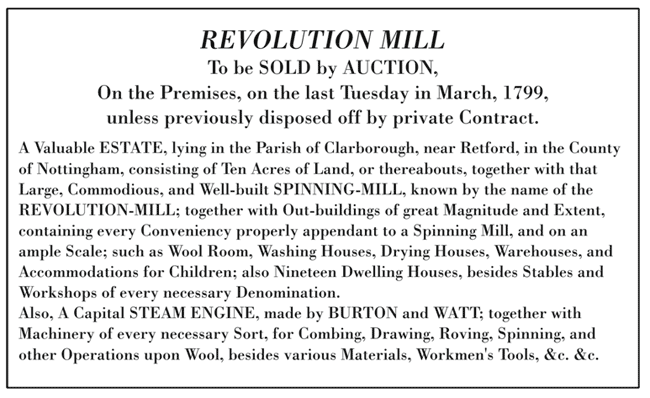Revolution Mill, East Retford
By Andy Nicholson
The following advert appeared in the March 1799 edition of the Leeds Intelligencer newspaper:

The story behind this advert is an interesting one. The Revolution Mill was the first attempt to develop a textile industry in Retford. Major John Cartwright (1740-1824), the man behind the ambitious scheme, was a prominent English radical and was the brother of Edmund Cartwright who invented the first power loom. After he left the navy John Cartwright devoted himself to furthering the cause of parliamentary reform. Among his proposals were universal suffrage, the secret ballot, annual elections and equal electoral districts.
Cartwright bought 10 acres of land on Spital Hill near the Chesterfield Canal in April 1788 with the intention of building a steam-powered wool spinning and weaving mill. We can only speculate as to what his motives were. It has been suggested that he was attempting to make money in order to address financial problems caused by inheriting his heavily mortgaged family estate at Marnham in the Trent valley. Another reason may well be his desire for a parliamentary seat which would be helped by setting himself up as a local employer and entrepreneur; in fact, he was invited to stand for one of Retford's parliamentary seats the following year and he referred to himself as "The Man of the Mill” in his campaign literature.
The mill was ceremonially opened on 5 November, 1788 in the centenary year of the ‘Glorious Revolution’ when William of Orange and his supporters deposed King James II. A commemorative dinner, at 2/6 per head, was held at the Crown Inn. However, the celebration was premature. It took over a year to get steam powered production underway and by 1790 the whole enterprise was in financial difficulty. It seems that Cartwright had not only underestimated the high cost of machinery had also failed to appreciate how far Retford was from the coalfield which added substantially to the cost of transporting coal to power his machinery. Furthermore, the mill was designed for 600 employees but it proved difficult to recruit sufficiently skilled workers from the local population.
The mill was advertised for sale in the newspapers and sale particulars give a clear idea of the scale of the site. The upper floor of the mill itself included a “lofty extensive reeling floor” and “wool, throwing, stores and turning rooms”; the second floor contained a cotton warehouse and “capacious spinning rooms”; the first floor had another spinning room “with shafts & going gears, drying room, store & machinery rooms”; the principal floor included drying and extensive combing rooms, a wash-house and two store rooms. There was also an engine house with a 32 horse-power steam engine, a dye house, blacksmiths’ shops, a children’s kitchen and dining room, a sorting room, two dormitories, wool store rooms, hand combing and drying-rooms, an agent’s house, 18 dwelling houses, a large kitchen garden, and a coach yard with stabling for seven horses.
However, the mill failed to sell despite the advertisement appearing on a weekly basis! It was not until August 1811 that the whole concern was auctioned off in separate lots at the White Hart Inn. The investors made a huge loss.
No trace of the mill has survived and it is interesting to consider how Retford would have developed economically if it had been successful.
